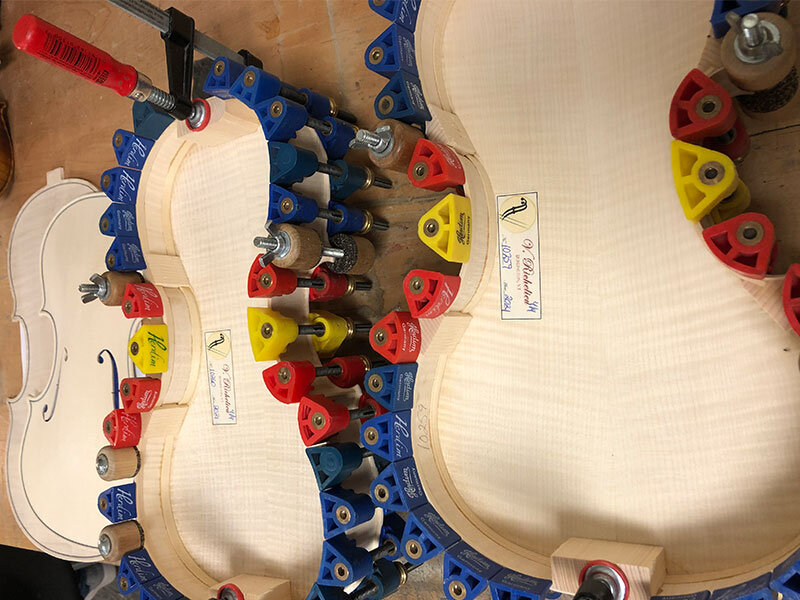Impact Of Glue
Why Is Glue Important For Lutherie?
Our Luthier - Paige shares her experience and information about everything we need to know about Glue.
I first started using hide glue when I attended the Violin Making School of America. I hadn't realized that people still used hide glue, so it was a topic I found interesting. Something I like about it is that the glue comes in a crystallized form, so you have to add water to it and heat it by placing the jar of glue into a saucepan of hot water. (Like a double boiler.) Since you are the one adding the water to the glue you can customize how it turns out. If you add less water, you'll have a thicker, tackier glue, while using more water will make the glue thinner and more slippery. I generally prefer a texture that is somewhere in between, but it does mean there are options to choose from depending on what I'm gluing. The fun part about this is that there isn't really a way to tell what texture your glue is without touching it. I'm constantly dropping the glue onto my fingers so I can see how the texture is and make sure it's what I'm looking for.
All About Glue
Most people don’t spend a lot of time thinking about glue. However, luthiers think about glue a lot, and it’s a much more interesting topic than you would think! The type of glue one uses on a violin can impact its longevity and our ability to repair the instrument, which means it’s important for us to make sure we’re using the best glue possible. But which glue is the best kind of glue for violin making? Most luthiers would say animal hide glue.
Image Of A Hide Glue
Hide Glue
The phrase ‘animal hide glue’ can make people think about animals, in particular horses, being sent to glue factories to be made into glue. However, that’s not the case. Most hide glue is made from cattle hides, which are readily available due to the mass consumption of beef around the globe. Cattle hide that can’t be used for leather is sent to hide glue manufacturers to be made into glue. While it seems gruesome, it means there’s less waste coming from the production of beef.
Hide glue is a centuries-old adhesive, which can be dated back to the ancient Egyptians. The ancient Egyptians primarily used hide glue to build the furniture found in pharaohs' tombs. This is evidenced by stone carvings found depicting the heating up of glue and the overall gluing process, as well as the glue still being intact on the chairs in those tombs. That’s some long-lasting glue!
But why do luthiers still use hide glue when there is a whole world of synthetic adhesives available to us today? Ultimately, no synthetic adhesive has the same properties as hide glue. Hide glue is water-soluble, which means if a mistake is made while gluing two pieces together, it is easy to reverse that mistake without damaging the wood in any way. But, this also means that high humidity and changes in the humidity can affect hide glue’s effectiveness. This is why violin seams open. Hide glue is very long-lasting. It won’t lose its strength over time as some other glues might. It is also very easy to customize the strength of your hide glue. For example, when joining two pieces of wood together to create one of the violin plates, you want incredibly strong glue that won’t come apart. However, when gluing a seam on the top plate of your violin, you want to use a weaker glue, so that if that same violin needs a repair that requires removing the top, it’s easy to do so without damaging the instrument further.
Other Glue Options
While most luthiers use hide glue, some choose to use casein glue or fish glue instead. Casein is a protein found in milk that can be dissolved in an alkaline solvent to create glue. Casein glue has better moisture resistance than hide glue, so it can take humidity and temperature changes better. This means casein glue can be a great option for luthiers that live in very humid locations. However, casein glue is much harder to remove than hide glue, which can make repairs difficult.
Fish glue is made from the skin and air bladders of non-oily fish, such as sturgeon. It has a much longer working time than hide glue and isn’t slippery, so it can make gluing a little easier. But, fish glue takes a much longer time to cure than hide glue does, so it’s not very convenient for luthiers working in a fast-paced shop environment.
Conclusion
Ultimately all glues have pros and cons when it comes to using them for lutherie. Most luthiers choose to use hide glue because of its water solubility, relatively quick cure time, and ease of removal, but it certainly isn’t the only option! Hopefully, this quick explanation of some of these glues gives you a better understanding of how your instrument was built and why we choose to use the glue that we do.




